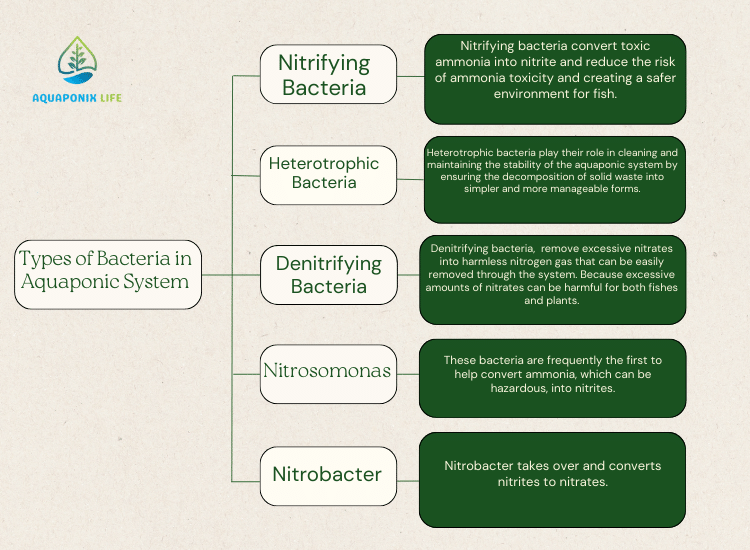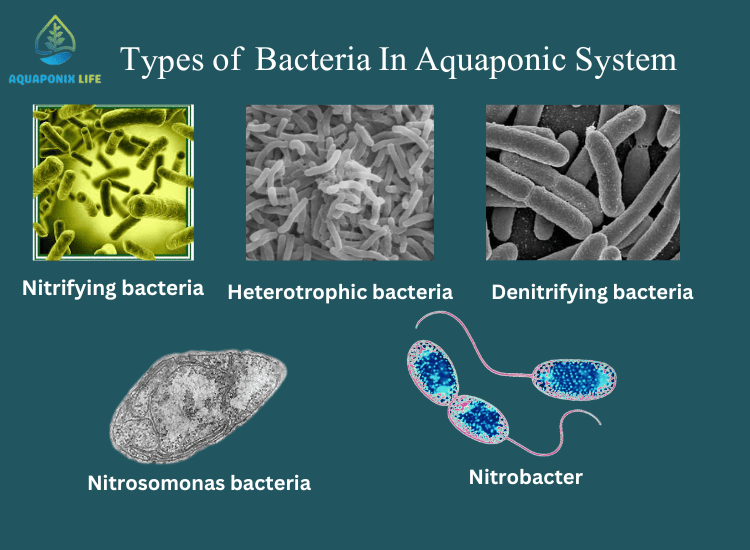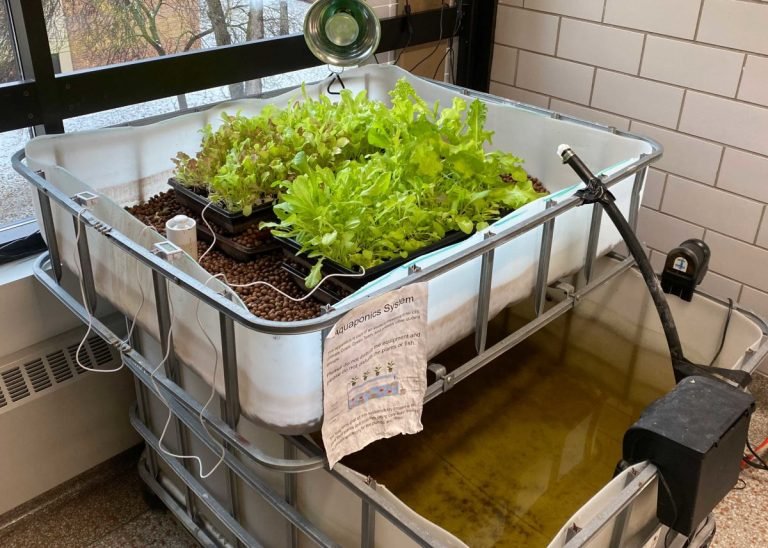Little Critters In Aquaponic System: A Complete Guide
A sustainable aquaponic system depends on the presence of bacteria in that system. Those bacteria not only convert the waste into useful nutrients but also help to maintain good water quality. In this blog post, we will review the role and what types of bacteria are important to maintain a healthy aquaponic system.

What are Bacteria?
Bacteria are single-celled microorganisms that live in a variety of environments. Some bacteria are harmful and cause diseases, but others are required to maintain a proper digestive system in animals. They are also helpful in decomposing dead organic matters. Now the question is this what bacteria is used in aquaponics? so here we are going to explain some types of bacteria in aquaponics system.
Types Of Bacteria In Aquaponic System:

Aquaponics is an efficient way of farming to produce both fish and vegetables and becoming a popular choice among many farmers due to various reasons.
To achieve a sustainable ecosystem, aquaponics heavily depends on bacteria that are present in aquaculture because those bacteria convert the waste into useful nutrients. A healthy aquaponic system depends on some little critters that work like an amazing intelligent team. Nitrifying bacteria, heterotrophic bacteria, denitrifying bacteria, nitrosomonas, and nitrobacter. These bacteria are crucial for a sustainable aquaponic system. Let’s find out in detail.
1: Nitrifying Bacteria:
It is one of the most important types of bacteria because these microscopic organisms are responsible for converting the toxic ammonia released by fish into nitrites. Though nitrites are also very harmful if present in sufficient amounts.
Now the game begins when another bacteria comes to play their part and convert these nitrites into nitrates that are much less harmful to fishes and then these nitrates are used by plants as a source of nutrition.
Functions of Nitrifying Bacteria in Aquaponics:
- Conversion of Ammonia to Nitrite: Nitrifying bacteria convert toxic ammonia into nitrite and reduce the risk of ammonia toxicity and creating a safer environment for fish.
- Conversion of Nitrite to Nitrate: Nitrite-oxidizing bacteria convert nitrite into nitrate, a less toxic form of nitrogen, serving as a valuable nutrient source for plants.
- Maintenance of Water Quality and Ecosystem Balance: Nitrifying bacteria prevent the buildup of harmful nitrogen compounds and it also reduces the risk of water contamination and fish health problems. It also ensures a steady supply of nutrients for plants, promoting growth and productivity.
2: Heterotrophic Bacteria:
Heterotrophic bacteria play their role in cleaning and maintaining the stability of the aquaponic system by ensuring the decomposition of solid waste into simpler and more manageable forms. The continuous flow of water, dead decaying plants, uneaten fish food and other organic matters can affect the water quality but heterotrophic bacteria interfere and prevent the build up of unwanted substances that may harm the aquaponic system.
3: Denitrifying Bacteria:
One of the most important bacteria is denitrifying bacteria, which remove excessive nitrates into harmless nitrogen gas that can be easily removed through the system. Because excessive amounts of nitrates can be harmful for both fishes and plants. These bacteria utilize them as a source of energy.
They can even survive in areas of low oxygen, such as the deeper layer of the grow bed or the media filters. Aquaponic enthusiasts successfully balanced and maintained the healthy population of denitrifying bacteria for a sustainable environment of the fish and plants.
4: Nitrosomonas:
These bacteria are frequently the first to help convert ammonia, which can be hazardous, into nitrites. Gram-negative members of the Betaproteobacteria class, nitrogensomonas, play a critical role in various ecosystems, particularly in wastewater treatment facilities.
They are obligatory chemolithoautotrophs that transform ammonia into nitrite, an essential component of the nitrogen cycle. Their cells are ellipsoidal or rod-shaped, with thick membranes, and they frequently create biofilms to block out light. Nitrosomonas improve plant bioavailability and release nitrous oxide, a greenhouse gas, as part of the biogeochemical nitrogen cycle.
5: Nitrobacter:
After Nitrosomonas, Nitrobacter takes over and converts nitrites to nitrates. Most plants prefer nitrates, which are nitrogen compounds. The fish will be able to dwell in safety, and the plants will find it easier to obtain the nutrients they require.
The Role of Bacteria in the Nitrogen Cycle:

Bacteria perform two important functions that are key to the existence of life on the earth.
Fixing a Nitrogen Cycle: Nitrogen fixation, in which microbes transform the atmosphere’s nitrogen into forms that can be used, such as nitrates or ammonia, is an essential step of the nitrogen cycle. Nitrogenfixing bacteria, such as Azotobacter, Rhizobium, and Cyanobacteria, coexist freely in the symbiotic environment or form partnerships with plants.
Role In Carbon Cycle.

Bacteria play an important role in nitrogen fixation. Without these bacteria life on earth is impossible because there is no nitrogen cycle. Bacteria fix these harmful nitrogen into a form that can be used by plants and animals.
Bacteria also play a vital role in the carbon cycle because it decomposes dead organic matter that releases carbon dioxide in an atmosphere that is needed by plants for the photosynthesis and the cycle begins here.
Benefits Of Bacteria In Aquaponic system:
Not all the bacteria are harmful, some are important to maintain a healthy life on earth otherwise the life would be in different places on the earth. If these bacteria do not clean water in a system, then maintaining an aquaponic system is difficult.
1. Bacteria facilitate the nutrient cycling process in an aquaponic system and provide a continuous supply that supports plant growth and development.
2: Bacteria are important to break down the solid organic and prevent the accumulation of unwanted substances in a system.
3: These bacteria form a natural filtration system that regulates the nitrogen compound level in water.
4: These bacteria actively remove the harmful substances.
5: Bacteria contribute to the overall stability and resilience of the aquaponic system.
6: These bacteria resistant to diseases breakout.
7: They remove the harmful pathogens and reduce the risk of infections among plants and fishes.
FAQs:
How long does it take for beneficial bacteria to establish themselves in a new aquaponic system?
The time requires for beneficial bacteria to establish themselves can vary depending on several factors, including water temperature, pH levels, and the presence of any existing bacteria. In general, it can take anywhere from a few weeks to a few months for a healthy bacterial population to become established. Adding commercially available beneficial bacteria cultures can help accelerate this process.
Can I use aquarium water to jumpstart the bacterial population in my aquaponic system?
Yes, using established aquarium water can be a good way to introduce beneficial bacteria to your new aquaponic system. However, ensure the aquarium is healthy and hasn’t been treated with antibiotics recently, as these can harm the desired bacteria. Start by adding small amounts of aquarium water to your system over time and monitor the overall health of your fish and plants.
Are there any risks associated with having too many bacteria in my aquaponic system?
While a healthy bacterial population is essential, an imbalance can occur. Excessive heterotrophic bacteria can lead to oxygen depletion in the water, harming fish. Regularly monitoring oxygen levels and maintaining a good ratio of organic matter to beneficial bacteria is crucial for preventing this issue.
How can I tell if the bacterial population in my aquaponic system is healthy?
There isn’t a single definitive test for a healthy bacterial population. However, some indicators suggest a balanced system:
- Clearwater quality
- Stable pH levels
- Efficient breakdown of fish waste
- Healthy plant growth
What are some signs that the bacterial population in my system might be unbalanced?
Signs of an unbalanced bacterial population include:
- Cloudy or foul-smelling water
- Fluctuating pH levels
- Accumulation of fish waste
- Stunted plant growth
How often should I clean the biofilter in my aquaponic system?
Biofilters shouldn’t require frequent cleaning, as this can disrupt the beneficial bacteria. However, occasional cleaning may be necessary to remove excess debris. The cleaning frequency depends on your system size and fish stocking density. Aim for gentle cleaning and avoid using harsh chemicals that can harm the bacteria.
Should I add molasses or sugar to my aquaponic system to feed the bacteria?
While some aquaponic enthusiasts recommend adding molasses or sugar as a food source for bacteria, it’s generally not necessary. The breakdown of fish waste and uneaten fish food usually provides enough organic matter for the bacteria to thrive. Adding excess sugars can lead to unwanted algae growth if not carefully monitored.
What are some natural ways to promote beneficial bacteria in my aquaponic system?
Here are some natural ways to encourage beneficial bacteria:
- Maintain good water flow and aeration to ensure adequate oxygen levels.
- Avoid overloading the system with fish or uneaten food, which can create excessive organic waste.
- Consider using organic fish food, as some conventional fish food additives can harm bacteria.
- Quarantine new fish before introducing them to the main system to prevent introducing pathogens.
Can I use commercially available probiotic supplements in my aquaponic system?
Some probiotic supplements specifically designed for aquaponics may be beneficial. However, it’s essential to choose products formulated for aquatic environments and follow the recommended dosage instructions carefully.
Are there any specific types of bacteria I can add to my aquaponic system for targeted benefits?
While most commercially available beneficial bacteria cultures focus on a broad spectrum of bacteria, some may target specific functions like nitrification or phosphate mobilization. Researching these options and their potential benefits for your specific aquaponic setup can be helpful.
Conclusion:
In conclusion, bacteria form the backbone of any successful aquaponic system. From the nitrifying bacteria that facilitate nutrient cycling to the heterotrophic denitrifying bacteria that optimize water quality, each type contributes to the overall sustainability of the ecosystem. Embracing the important role bacteria play in maponics enables us to create thriving and harmonious environments that support the growth of both fish and plants. So next time you marvel at the flourishing greenery of an aquaponic system, remember to give credit to the unsung heroes—the bacteria.







